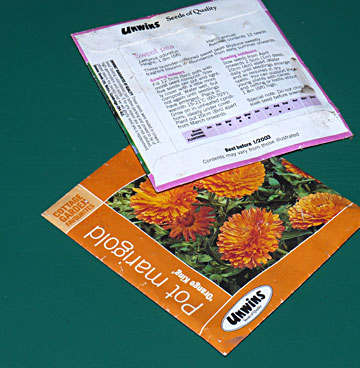Growing Plants from Seed
Sowing Time for Seeds is Important
Appreciate that there will be considerable time between buying the seeds and seeing the plants in full bloom in your garden, so your starting point is the time of year when your chosen plants will be in bloom or ready for harvesting so that you can work back from there to the time when you need to sow the seed.
Invariably, you will find sowing, blooming and cropping information printed on the seed packets, which will act as confirmation of the information you gleaned from the books and catalogues.
If you are late in buying your seed, there isn’t much you can do to short cut the sowing and growing period, without a great deal of trouble and cost. On the other hand, if you buy your seed a few weeks too early, they won’t come to any harm as long as they remain sealed in their packets and are kept in a cool, dry environment. The best option, therefore, is to do your planning and then buy a little earlier than you need.

Sowing the Seed
The main issue when planting most seeds is to ensure each one is enclosed in a pocket of moisture. This can be achieved by sprinkling the seed on the surface of the soil and then covering them with a further thin layer of soil. Beware of burying them too deep or they may never manage to grow. The depth of the covering layer should be about the thickness of the seeds being sown.
Using the term “sprinkle” can also be misleading. You should avoid sowing them too thickly as this will lead to competition between the emerging plants which in turn can result in weak spindly plants that are more prone to disease. Sowing seeds about half a centimetre to a centimetre apart (roughly) is a good general rule.
This general sowing advice applies to most seed but there are exceptions. However, a quick read of the instructions on the packet will alert you if something needs to be changed.
You may well find that packets of smaller seeds contain too many for the advice given above so that you are tempted to sow them more thickly. For the most part it is better to sow thinly and keep any seeds that are surplus to requirements for the following year.
Don’t forget to mark each pot with whatever it is you have sown. You can spend a small fortune on fancy markers that may look very pretty but otherwise have no benefits over much cheaper home-made alternatives.
Some people use a stick to pierce the seed packet and then plant the stick in the pot. Fine if you only have one pot but not so good if you have sown a number of varieties in multiple pots. A practical alternative is to cut strips from a plastic food container – yogurt pots, for example. Use a waterproof marker to write out the labels and insert them into the side of each pot.
Read more about Growing from Seed |
Read more about Plants |
